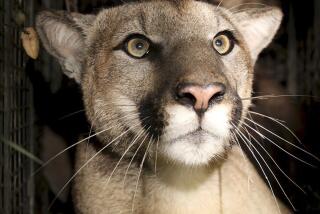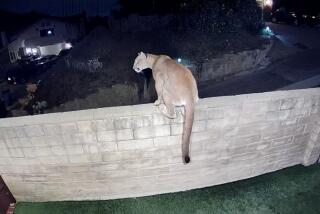Sightings, Skeptics Surround Cougars
CONCORD, N.H. â Northern New Englandâs largest predator is living up to its reputation as a recluse.
Confirmed sightings of cougars in Maine and Vermont in recent years, and a Christmas Eve video, have some people excited about the prospects of the creatureâs return to its original habitat.
âThere are people out there who believe that wolves would come back on their own and mountain lions would come back on their own,â said Rosemary Conroy, of the Society for the Preservation of New Hampshire Forests.
As for herself, Conroy said she believes cougar sightings are more likely a rural myth, but added that âas long as there are large blocks of land out there, itâs possible.â
The stateâs biologists remain skeptical.
New Hampshire Fish and Game biologist Kent Gustafson said sightings in the Northeast are notoriously difficult to document. While it is rare to spot one of the shy creatures in Western states, where they are much more common, it is even more rare in the Northeast.
Mountain lions, also called cougars, pumas, panthers and catamounts, are the largest native North American cat. Gustafson said mature cougars typically range from 90 to 120 pounds and are 5 feet to 6 feet long from head to tail. They primarily hunt deer.
Solitary animals, they roam territories as great as 150 square miles. They have big yellow eyes, a keen nose and the ability to sprint 40 mph and leap 20 feet into a tree. Wild cougars live about 10 or 12 years.
Settlers in the Northeast killed most of the big cats, and pushed them north, while trying to protect their farms, Gustafson said. By the late 1800s, they were believed to be eradicated from the region.
Although New Hampshire hasnât had a confirmed cougar sighting since 1885, Maine and Vermont have had more recent run-ins.
In 1996, lab tests confirmed a report of a mountain lion in Cape Elizabeth, Maine. In August, several unconfirmed sightings in the Fryeburg area and over the New Hampshire border prompted Maine wildlife officials to ask selectmen to warn residents.
A confirmed mountain lion sighting was reported in Craftsbury, Vt., in the winter of 1994-1995. State game wardens followed the animalsâ tracks and recovered scat and other physical evidence they sent to the U.S. Department of Fish and Wildlifeâs forensics lab for DNA analysis.
Those tests confirmed that hair in the scat came from mountain lions. Subsequent tests called into question the initial findings, but after additional review, the Vermont Fish and Wildlife Department stood by its assessment.
The most recent sighting came on Christmas Eve morning. Maureen Clark, a photographer and bear trainer in Lincoln, said she and a nephew saw a small, rusty colored, long-tailed animal clearly in her backyard. However, by the time she grabbed her video camera, the cat had wandered away.
âItâs not like it was a monster, but it wasnât a house cat,â she said.
Fish and Game biologists have studied the six-second tape but reached no conclusion, because the view of the animal is largely blocked by trees and leaves. Spokesman Eric Aldrich said some believe the animal could be a mountain lion, but Gustafson and biologist Mark Ellingwood are skeptical.
Gustafson and Ellingwood pointed to what seems to be a striped tail and pointed ears on the cat in the video. They said mountain lions normally are solid colored with rounded ears. Gustafson speculated that it could be a large feral cat, or a much more common bobcat with an unusually long tail.
Ellingwood said biologists would love to confirm sightings, but they must rely on hard evidence such as tracks, scat, hair or photos.
âItâs like chasing ghosts,â he said.
More to Read
Sign up for Essential California
The most important California stories and recommendations in your inbox every morning.
You may occasionally receive promotional content from the Los Angeles Times.










